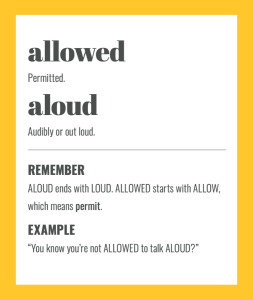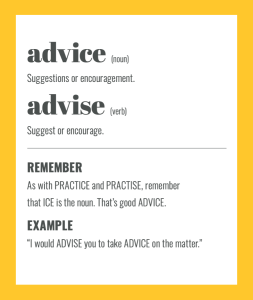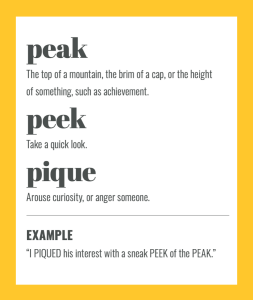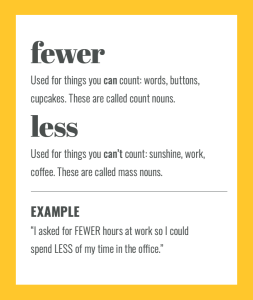Brake vs break: do you know the difference?
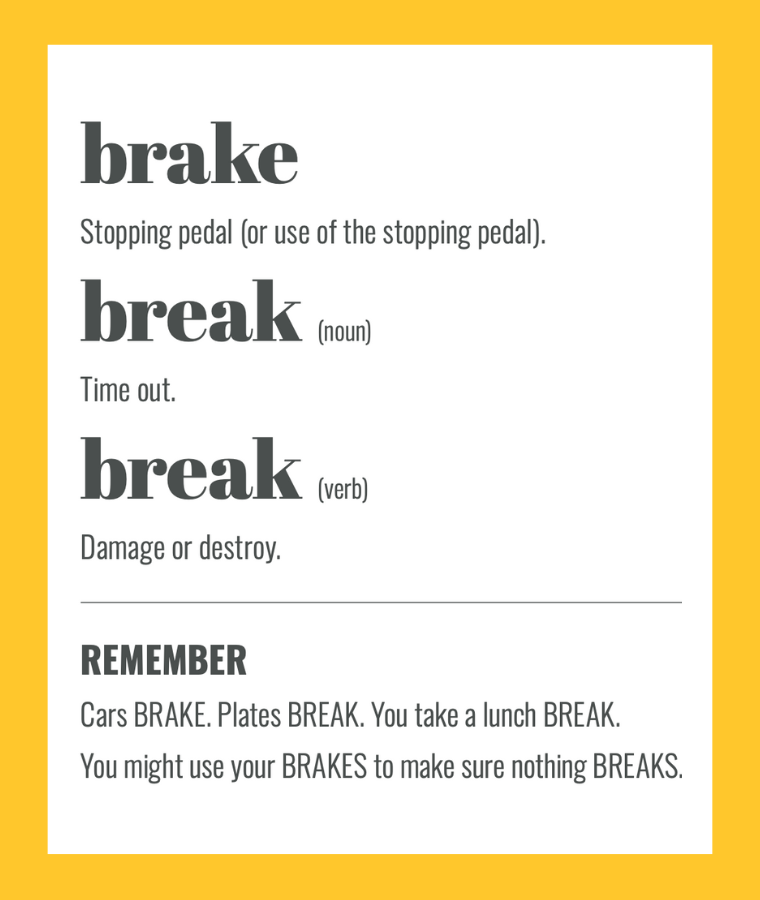
BRAKE vs BREAK: which is which? Tips and tricks to remember the difference
BRAKE and BREAK are easy to confuse – especially if you’re new to the English language. The fact that the two words sound the same – they’re homophones – means people commonly mix them up.
Here are my simple spelling tips to remember the difference between BRAKE and BREAK.
When to use BREAK
BREAK can be both a noun and a verb.
As a noun, BREAK means time out.
“It’s time for your lunch BREAK”
“Let’s take a BREAK”
As a verb, BREAK means damage or destroy.
“I dropped my phone but luckily it didn’t BREAK.”
When to use BRAKE
BRAKE can be both a noun and a verb.
As a noun, a BRAKE is the stopping pedal in a car or other vehicle.
As a verb, BRAKE means to slow down or stop – for example, a car.
Noun: “Remember to use the BRAKE to stop the car in good time.”
Verb: “I had to BRAKE hard to avoid the oncoming cyclist.”
Get more tips in The Little Book of Confusables
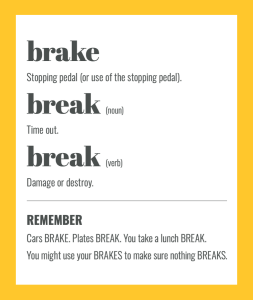
BREAK vs BRAKE. Excerpt from The Little Book of Confusables by Sarah Townsend.
Aloud vs allowed: top tips to remember the difference
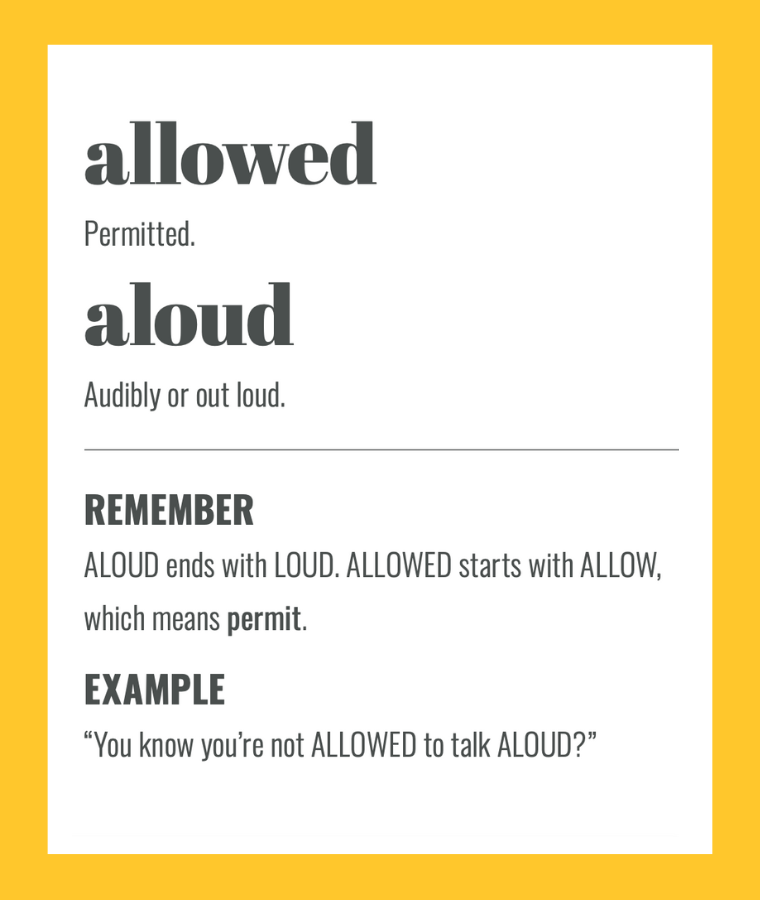
ALOUD vs ALLOWED: which is which? Tips and tricks to remember the difference.
ALOUD and ALLOWED are easy to confuse. The fact that the two words sound the same – they’re homophones – means people commonly mix them up.
Here are my simple tips to remember the difference between ALOUD and ALLOWED.
ALOUD means out loud. Remember that this spelling ends in LOUD.
“I’m just thinking ALOUD.”
ALLOWED means permitted. Remember it starts with ALLOW.
“You are ALLOWED to read ALOUD.”
In its verb form, ALLOWED is that past tense of ALLOW.
“She ALLOWED him to read ALOUD.”
Get more tips in The Little Book of Confusables
Advise vs Advice: top tips to remember the difference

ADVISE vs ADVICE: do you know the difference?
ADVISE and ADVICE are easy to confuse. The fact that they look so similar trips people up time and time again.
Here are my simple tips to remember the difference between ADVISE and ADVICE.
ADVISE is a verb that means suggest, encourage or tell someone to do something.
“I ADVISE you to learn the difference between ADVISE and ADVICE.”
ADVICE is a noun.
The best way to remember this is that it ends with ICE, which is also a noun:
“That’s good ADVICE.”
Understanding the difference between the ISE and ICE endings can help you to remember the spellings of other similar word pairs.
Think DEVISE (verb) and DEVICE (noun), or PRACTISE (verb) and PRACTICE (noun).
(Note that the latter applies to the British English spelling only – US English has its own rules.)
Get more tips in The Little Book of Confusables
Peak, peek or pique: simple tips to remember the difference

Peak vs peek vs pique: do you know the difference? These tips will show you how to use these commonly confused words.
Years ago there was an account on Twitter that automatically responded when people spelled ‘sneak PEEK‘ as ‘sneak PEAK‘.
I’m kinda disappointed it no longer exists (changing the world, one spelling tweet at a time is right up my streat… sorry – street).
But there’s no doubt these tricksy spellings are easy to confuse. Here are my top tips to remember the difference between PEEK and PEAK… with PIQUE thrown in for good measure.
When to use PEAK
It’s easy to remember that the PEAK is the top or pinnacle of something. Just think of the A being like the top of a mountain.
When to use PEEK
A PEEK is a cheeky glance (or peep).
Think of the two EEs in CHEEKY, and the two EEs in PEEK – or like two eyes peeping.
When to use PIQUE
PIQUE means to arouse curiosity, or to make someone angry.
You might do something in a fit of PIQUE, but never ‘a fit of PEEK‘ or ‘a fit of PEAK‘ – though you need to be fit to climb a PEAK (sorry – couldn’t resist).
Get more tips in The Little Book of Confusables
Fun, memorable spelling and usage tips for 600 commonly confused words, packed into 300+ gorgeous pages for just £11.95. You’ll wonder how you managed without it!
2023 GOLD award winner at the eLit book awards.
Less vs fewer. A simple tip to get it right every time
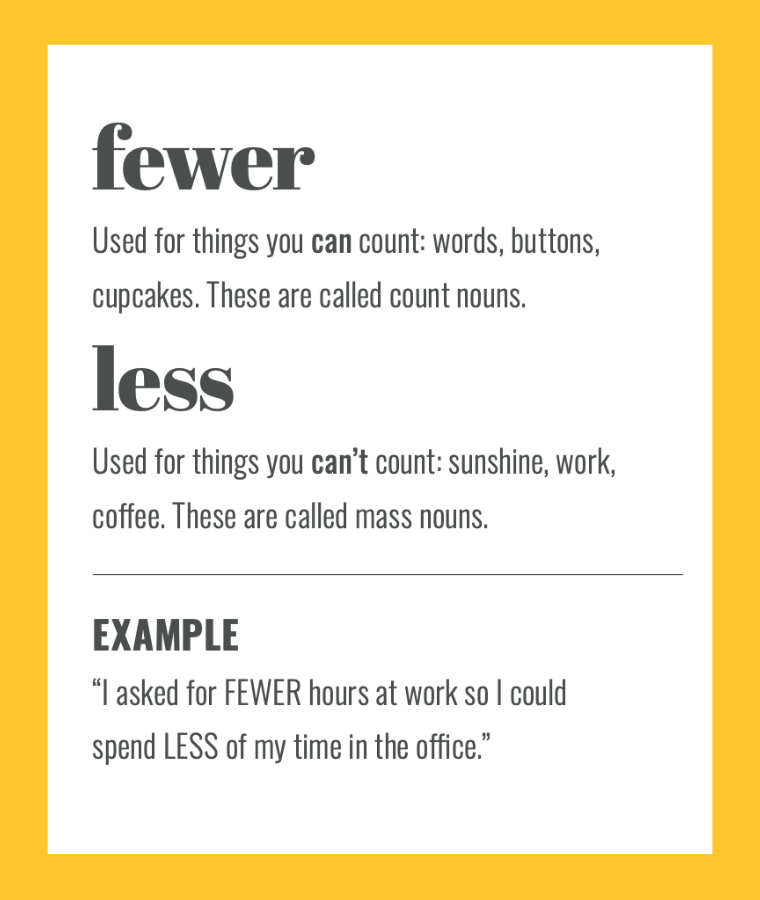
There are two types of people – those who are irritated by supermarket Five items or less signs (Fewer! It should be FEWER!) and those who don’t know the difference. Do you know the super simple tip to tell them apart?
Use LESS for things you can’t count:
- less sunshine
- less work
- less coffee
Use FEWER for things you can count (like the items in your shopping basket):
- fewer words
- fewer buttons
- fewer cupcakes
So there you go. If you can count it, use FEWER. If you can’t, use LESS.
More tips = fewer mistakes + less confusion.
Bonus tip
Once you know that things you can count are called ‘count nouns’ and things you can’t count are called ‘mass nouns’ you can apply the same logic to MANY and MUCH.
Use MANY for things you can count, and MUCH for things you can’t.
For example:
- Using too many words can confuse your message.
- Too much confusion can prevent customers from choosing your business.


